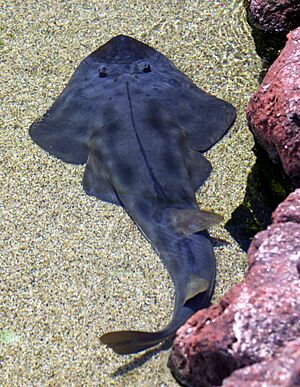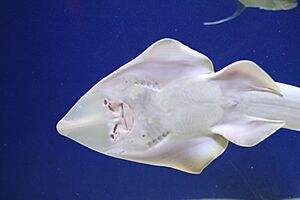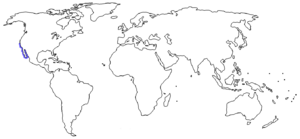Shovelnose guitarfish facts for kids
Quick facts for kids Shovelnose guitarfish |
|
|---|---|
 |
|
| Dorsal view | |
 |
|
| Ventral view | |
| Conservation status | |
| Scientific classification | |
 |
|
| Range of P. productus | |
| Synonyms | |
|
Rhinobatos productus |
The shovelnose guitarfish, Pseudobatos productus, is a type of ray that belongs to the family Rhinobatidae. It gets its name from its flat, shovel-like snout. This unique fish looks like a mix between a shark and a ray. In fact, people first thought it was a shark because of its dorsal fins, which are on its back.
This ray has a special way of sensing its surroundings. It has tiny magnetic particles in its inner ear. Scientists believe these particles help the shovelnose guitarfish feel movements and possibly even sense the Earth's magnetic field. This could help it navigate in the ocean. The shovelnose guitarfish also has very good eyesight compared to other fish like it. Its eyes are well-developed and connect strongly to its brain.
Life Cycle and Size
Shovelnose guitarfish grow up slowly. They become adults when they are about seven to eight years old. At this age, male guitarfish are usually between 90 to 100 centimeters (about 35 to 39 inches) long. Females are a bit larger, around 99 centimeters (about 39 inches) long.
These rays can live for up to 11 years. When they are fully grown, males can reach about 120 centimeters (about 47 inches) in length. Females grow even bigger, reaching up to 137 centimeters (about 54 inches).
Where They Live
You can find shovelnose guitarfish along the coast of California. Their home range stretches from central California all the way south to the Gulf of California.
Interestingly, the guitarfish living in the Gulf of California are a bit different from those found elsewhere. They have small differences in their bodies and their DNA. This shows that the groups in the Gulf of California have been separated from the others for a long time. Because of these differences, it's important to protect each group to keep the species strong and diverse.
Human Interaction
Fishing for Fun
People enjoy catching shovelnose guitarfish for sport. You can find them in the shallow waters along the California coast, especially near the surf. If you want to catch one, good bait includes sand crabs, different types of bivalves like mussels, or other live or dead bait.
As Food
The shovelnose guitarfish is also used as food. The main parts eaten are the body, tail, and a section called the loin. These usually come from adult fish. Sometimes, in markets, it's called "shark steak." It's often served fried, but it can also be prepared in dishes like cocktails or kebabs. In Santa Barbara, California, you might even find it sold as fish and chips on the piers. Dried shovelnose guitarfish of all sizes are also sold in shell shops, especially from central California down to Baja California.
Gallery



